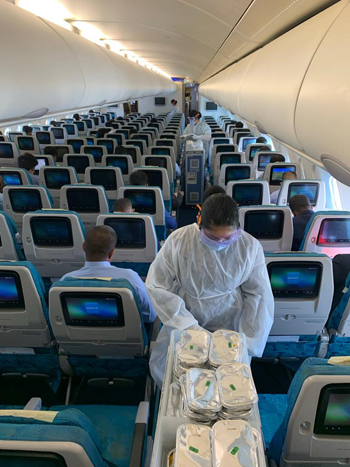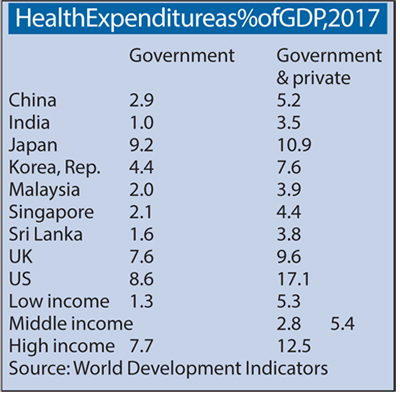Super healthcare, leading to despair
View(s):
A group of stranded Sri Lankans brought back from Pakistan this week on board a SriLankan Airlines aircraft.
Last week I had a series of email exchanges with Prof. Premachandra Athukorala, Professor of Economics at the Australian National University. Our communication included, among other things, a discussion over an interesting topic – coronavirus and emerging protectionism. However, this is not the issue I am going to discuss in this column today. I will leave it for the coming weeks.
In one of his emails, Prof. Athukorala sent me an attachment – a paper published in the March/April 2020 Issue of Foreign Affairs journal, titled “The Epidemic of Despair: Will America’s Mortality Crisis Spread to the Rest of the World?” The paper shows how the American healthcare system has led to people’s despair and, then to deaths of despair, instead of their well-being! It is not a joke as the paper is written by two Emeritus Professors of the Princeton University – Anne Case and Angus Deaton while Deaton was also a Nobel Laureate in 2015.
I am not exaggerating that the findings of the above paper would make people scared of the issue! Before I bring some of them for our discussion here, let me elaborate something that surprised the world in the past few weeks.
Super healthcare?
In the words of a Sri Lankan medical doctor working in the US, “while in Sri Lanka the government is chasing after people, here in rich countries people are chasing after government”. The statement meant that in Sri Lanka, the government authorities are after people to track the COVID-infected ones and to treat them in the government hospitals. People in some of the rich countries do not have that privilege so that they are after the government authorities seeking their help for treatment, which is available to critically ill-infected patients only. As the health systems have failed to meet the health requirements of exorbitant numbers of COVID cases, the COVID pandemic too appears to have gone out of control.
In the US – the most affected country now -, the number of infected people reached one million cases this week; there were already more than 45,000 deaths reported. The irony is that the US has the highest health expenditure in the world! Obviously, there are answers beyond the healthcare system, but it is true that the US spends 17 per cent of its GDP on health expenditure and the government alone 8.6 per cent of GDP. The difference between the two figures shows the private expenditure, including private health insurance costs.
The US health expenditure as a percentage of GDP is significantly higher than the average for the high-income countries as well. The average health expenditure for high-income countries is 12.5 per cent of GDP, and public health expenditure is 7.7 per cent of GDP.
We should not skip looking at Sri Lanka’s case too. In terms of public health expenditure, which is 1.6 per cent of GDP, it is significantly low and even lower than the average for middle-income countries. It seems that the private spending on health by Sri Lankans is more than their public spending, as shown by the total health expenditure of 3.8 per cent of GDP.
Sri Lanka’s health capacity – in terms of expenditure on health, health infrastructure, and human resources – is rather low, and much lower than even the “middle income” country average. Therefore, without a tight lockdown strategy which has caused a high economic and social cost, it would be difficult for Sri Lanka to bear up possible exponential growth of the COVID-19 infection. According to a technical analyses by the Institute for Health Policy (IHP), Sri Lanka needs to increase its testing of COVID-19 from about the current level of 250 to at least 2,000 RT-PCR tests a day and, ideally to 6,000 tests a day. The analysis shows the weak health capacity of Sri Lanka to handle the COVID-19 issue, implying that the country would not have made it without a strict lockdown strategy.
But the question remains to be asked – what about the US, which has a “super healthcare” expenditure, according to the published statistics. It is true that most of the rich countries were, knowingly or unknowingly, reluctant to compromise on its massive economic costs in a rich country. But statistics too need to be interpreted with caution.
Deaths of despair
Although it is not directly related to the COVID issue, as Anne Case and Angus Deaton have identified in their paper mentioned above, in the US since the 1990s there has been an unusual increase in “deaths of despair” – deaths caused by drug overdose, alcohol-related liver disease, and suicide. And younger generations have been vulnerable to this issue more than their older generations. Why on earth, has it to do with US health care? Even if it had, as the country with the highest spending on health in the world, anyone would anticipate the opposite – a reduction in deaths of despair.
Here goes the story, as analysed by the authors. In the 20th Century, the US economy was growing and becoming rich so that the country was able to achieve higher levels of health standards as reflected in the decline in mortality rates, increase in life expectancy, and the improvement in other health indicators.
Since the 1990s, the economic conditions started to change against the average Americans who are less-educated and less-skilled people from the working classes. Gradually falling real wages and increasingly depleting job opportunities for them have caused them to face hopelessness about life which is reflected in their personal and social behaviour patterns as well as in the growing inequalities and divisions.
 What is the root cause? Labour became costly, and even much costlier due to high health cost incurred by the employers through expensive health insurance cost. In response, the job market gradually became smaller and smaller for the less-educated and less-skilled working class. Investment flew away from the US to developing countries to seek cheap labour on the one hand, and the remaining US companies launched an automation strategy to cut down the labour demand on the other hand.
What is the root cause? Labour became costly, and even much costlier due to high health cost incurred by the employers through expensive health insurance cost. In response, the job market gradually became smaller and smaller for the less-educated and less-skilled working class. Investment flew away from the US to developing countries to seek cheap labour on the one hand, and the remaining US companies launched an automation strategy to cut down the labour demand on the other hand.
This is where some rich countries failed to handle their prosperity. Health is a business in the US, where the public sector played a small role even though the country has the highest health expenditure in the world. Private spending on health by households and insurance schemes is also as high as public spending. The super healthcare has finally led to marginalise the working class driving them into despair and to deaths of despair.
Stealing US jobs
The US lost the jobs and incomes of the working class not only due to high labour costs inflated by health costs, but also due to globalization and outsourcing – a natural outcome of economic progress. How does a country respond to this issue? Should that country cut off economic progress and be contended with what it has? This is a question that we need to discuss further.
Over the past three years, the US has been trying to bring their outsourced investment back to the US. In spite of big public spending, government incentives and protectionist policies, the effort has not derived any significant result. Instead of that, if all such efforts and resources had been diverted to bring affordable healthcare to the working class as well as to equip them with higher levels of education and skills, I wonder whether it would have been a better strategy.
(The writer is a Professor of Economics at the University of Colombo and can be reached at sirimal@econ.cmb.ac.lk)




